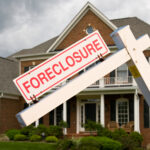An estimated 1.4 million (1,355,909) residential homes in the U.S. remain unoccupied, according to ATTOM‘s fourth-quarter 2024 Vacant Property and Zombie Foreclosure Report. That percentage, or one in 77 households nationwide, is about the same as it was in the third quarter and only somewhat higher than it was a year ago.
In Q4 of this year, 215,601 residential properties in the U.S. were in foreclosure, according to the data. This represents a decrease of 32.8% from Q4 of 2023 and 3.3% from Q3 of 2024. In Q4 of 2024, roughly 7,100 of such pre-foreclosure properties remain unoccupied as zombie foreclosures, or pre-foreclosure properties that the owners have abandoned. Although it is down 20.2% from a year ago, that number is somewhat higher than it was in the previous quarter.
Zombie homes currently make up just one out of every 14,591 dwellings in the U.S., continuing a long-term trend in which they constitute a relatively small percentage of the country’s overall housing stock. One of the lowest ratios in the last five years, it is essentially stable from one in 14,776 in the previous quarter but significantly lower than one in 11,412 in Q4 of last year.
Despite their potential to draw in vandalism and spread community blight, zombie foreclosures continue to have little to no effect on the majority of local housing markets. That phenomena is still one of the many long-lasting consequences of the 13-year-old housing market bubble that has occurred across the country.
U.S. Zombie Foreclosures Decreasing Annually but Increasing Quarterly
In Q4 of 2024, owners countrywide evacuated 7,109 residential homes that were at risk of foreclosure. This was a decrease from 8,903 in Q4 of 2023 but an increase of 1.5% from 7,007 in Q3 of 2024. In 30 states, the number of zombie properties has increased every three months, typically by less than 20. In some 20 states, the number has decreased or remained unchanged.
The biggest percent decreases from Q4 of 2023 to Q4 of 2024 in states that had at least 50 zombie homes a year ago were in:
- Connecticut (zombie properties down 87% from 100 to 13)
- Iowa (down 76% from 281 to 68)
- North Carolina (down 73% from 195 to 53)
- New Mexico (down 72% from 81 to 23)
- Oklahoma (down 71% from 197 to 58)
The only annual increases among states that had at least 50 zombie foreclosures in Q4 of 2024 were in:
- Kansas (zombie properties up 126% from 35 to 79)
- Arizona (up 114% from 28 to 60)
- Florida (up 65% from 1,199 to 1,974)
- Texas (up 52% from 126 to 191)
- New Jersey (up 14% from 188 to 215)
“The near-total disappearance of zombie foreclosures has been and still is one of the more subtle, but important benefits of the country’s soaring housing market. Those properties have gone from a plague in many areas of the U.S. following the Great Recession of the late 2000s, when millions of homes fell into foreclosure, to a distant memory in most communities today,” said Rob Barber, CEO for ATTOM. “That’s unlikely to change much in the near future given that record home prices are keeping home-equity levels at historic highs and foreclosures cases dropping. On top of that, the supply of homes is so tight that even when a property is abandoned, buyers are more likely to swoop in and pick it up.”

Overall Vacancy Rates See Small Changes
For 11 consecutive quarters, the vacancy rate for all residential properties in the U.S. has stayed relatively constant at 1.3%. The most recent percentage, 1.31% (one in 77 properties), is up somewhat from 1.2% in Q4 of last year and is the same as it was in Q3 of 2024.
States with the highest vacancy rates for all residential properties:
- Oklahoma (2.37% or one in 42 homes during Q4 of this year)
- Kansas (2.28% or one in 44)
- Missouri (2.15% or one in 47)
- Alabama (2.11% or one in 47)
- West Virginia (2.08% or one in 48)
Those with the lowest overall vacancy rates:
- New Hampshire (0.34% or one in 296 homes)
- Vermont (0.40% or one in 248)
- New Jersey (0.46% or one in 216)
- Idaho (0.50% or one in 200)
- Connecticut (0.57% or one in 175)
High-Level Highlights from Q4 of 2024:
Among the 170 U.S. metro regions with at least 100,000 residential properties in Q4 of 2024, the highest rates of zombie foreclosures were found in those with at least 100 properties at risk of foreclosure were in:
- Peoria, IL (22.4% of properties in the foreclosure process are vacant)
- Toledo, Ohio (11.6%)
- Wichita, KS (9.9%)
- Evansville, IN (9.2%)
- Canton, Ohio (8.8%)
Major metro regions with at least 500,000 residential properties and at least 100 homes in danger of foreclosure in Q4 of 2024 have the highest rates of zombie foreclosure were found in:
- Cleveland (8.5% of homes in the foreclosure process are vacant)
- Indianapolis (8.4%)
- St. Louis (8.4%)
- Kansas City, MO (6.5%)
- Baltimore (6.4%)
Approximately 871,200 (or 3.5%) of the 25 million investor-owned residences in the U.S. as of Q4 of 2024 remain unoccupied.
The highest levels of vacant investor-owned homes are in:
- Indiana (6.7%)
- Illinois (5.9%)
- Alabama (5.9%)
- Oklahoma (5.8%)
- Kansas (5.7%)
In Q4 of 2024, some 13.9% of the approximately 12,000 bank-owned, foreclosed residences in the U.S. are unoccupied.
In states with at least 50 vacant bank-owned homes, the largest vacancy rates are in:
- Missouri (24.5%)
- Ohio (24.1%)
- Indiana (23.7%)
- Illinois (19.6%)
- Michigan (17.7%)
The highest zombie-foreclosure rates in U.S. counties with at least 500 properties in the foreclosure process during Q4 of 2024 are in:
- Broome County in Binghamton, NY (15% of homes in the foreclosure process are vacant)
- Marion County in Indianapolis (9.9%)
- Cuyahoga County in Cleveland(9.7%)
- Niagara County in Niagara Falls, NY (9.3%)
- Pinellas County in St. Petersburg, FL (7.9%)
New York accounts for 66 of the top 100 ZIP codes with enough data to be analyzed, where zombie properties make up the biggest percentage of all residences.
The largest portions are in:
- ZIP code 61605 in Peoria-Peoria County, IL (one in 168 homes)
- ZIP code 61603 in Peoria-Peoria County, IL (one in 232)
- ZIP code 14892 in Waverly-Tioga County, NY (one in 260)
- ZIP code 13795 in Kirkwood-Broome County, NY (one in 284 homes)
- ZIP code 13350 in Herkimer (Herkimer County), NY (one in 287)
Zombie foreclosures can be just as spooky as the Halloween season, especially as nationwide housing supply remains scarce, despite an uptick in new construction and more home sellers gaining the motivation to enter the market.
To read the full report, including more data, charts, and methodology, click here.







